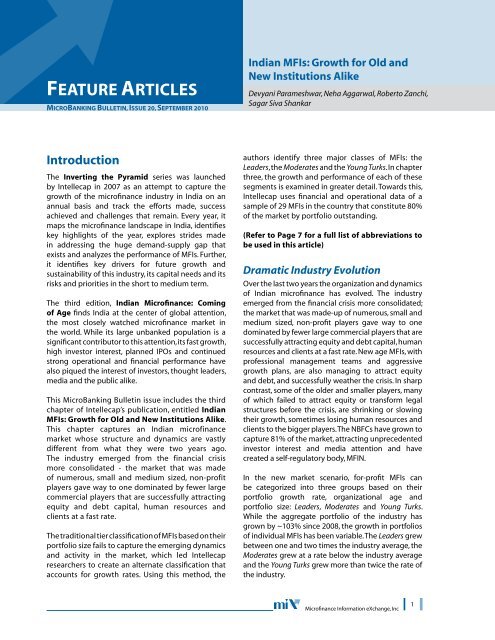THE MICROBANKING BULLETIN No. 20 - Microfinance Information ...
THE MICROBANKING BULLETIN No. 20 - Microfinance Information ...
THE MICROBANKING BULLETIN No. 20 - Microfinance Information ...
You also want an ePaper? Increase the reach of your titles
YUMPU automatically turns print PDFs into web optimized ePapers that Google loves.
FEATURE ARTICLES<strong>MICROBANKING</strong> <strong>BULLETIN</strong>, Issue <strong>20</strong>, SeptemBER <strong>20</strong>10Indian MFIs: Growth for Old andNew Institutions AlikeDevyani Parameshwar, Neha Aggarwal, Roberto Zanchi,Sagar Siva ShankarIntroductionThe Inverting the Pyramid series was launchedby Intellecap in <strong>20</strong>07 as an attempt to capture thegrowth of the microfinance industry in India on anannual basis and track the efforts made, successachieved and challenges that remain. Every year, itmaps the microfinance landscape in India, identifieskey highlights of the year, explores strides madein addressing the huge demand-supply gap thatexists and analyzes the performance of MFIs. Further,it identifies key drivers for future growth andsustainability of this industry, its capital needs and itsrisks and priorities in the short to medium term.The third edition, Indian <strong>Microfinance</strong>: Comingof Age finds India at the center of global attention,the most closely watched microfinance market inthe world. While its large unbanked population is asignificant contributor to this attention, its fast growth,high investor interest, planned IPOs and continuedstrong operational and financial performance havealso piqued the interest of investors, thought leaders,media and the public alike.This MicroBanking Bulletin issue includes the thirdchapter of Intellecap’s publication, entitled IndianMFIs: Growth for Old and New Institutions Alike.This chapter captures an Indian microfinancemarket whose structure and dynamics are vastlydifferent from what they were two years ago.The industry emerged from the financial crisismore consolidated - the market that was madeof numerous, small and medium sized, non-profitplayers gave way to one dominated by fewer largecommercial players that are successfully attractingequity and debt capital, human resources andclients at a fast rate.The traditional tier classification of MFIs based on theirportfolio size fails to capture the emerging dynamicsand activity in the market, which led Intellecapresearchers to create an alternate classification thataccounts for growth rates. Using this method, theauthors identify three major classes of MFIs: theLeaders, the Moderates and the Young Turks. In chapterthree, the growth and performance of each of thesesegments is examined in greater detail. Towards this,Intellecap uses financial and operational data of asample of 29 MFIs in the country that constitute 80%of the market by portfolio outstanding.(Refer to Page 7 for a full list of abbreviations tobe used in this article)Dramatic Industry EvolutionOver the last two years the organization and dynamicsof Indian microfinance has evolved. The industryemerged from the financial crisis more consolidated;the market that was made-up of numerous, small andmedium sized, non-profit players gave way to onedominated by fewer large commercial players that aresuccessfully attracting equity and debt capital, humanresources and clients at a fast rate. New age MFIs, withprofessional management teams and aggressivegrowth plans, are also managing to attract equityand debt, and successfully weather the crisis. In sharpcontrast, some of the older and smaller players, manyof which failed to attract equity or transform legalstructures before the crisis, are shrinking or slowingtheir growth, sometimes losing human resources andclients to the bigger players. The NBFCs have grown tocapture 81% of the market, attracting unprecedentedinvestor interest and media attention and havecreated a self-regulatory body, MFIN.In the new market scenario, for-profit MFIs canbe categorized into three groups based on theirportfolio growth rate, organizational age andportfolio size: Leaders, Moderates and Young Turks.While the aggregate portfolio of the industry hasgrown by ~103% since <strong>20</strong>08, the growth in portfoliosof individual MFIs has been variable. The Leaders grewbetween one and two times the industry average, theModerates grew at a rate below the industry averageand the Young Turks grew more than twice the rate ofthe industry.<strong>Microfinance</strong> <strong>Information</strong> eXchange, Inc
















